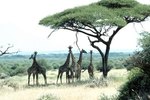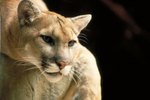Wild horses (Equus callabus) exist on public lands managed by the Bureau of Land Management in western states, such as Arizona, California, Colorado, Montana, Nevada, New Mexico, North Dakota, Oregon, Utah and Wyoming. They live within an ecosystem that’s a combination of herd groups, their native state’s habitat, terrain, climate, plants and grasses and other wildlife species, which include elk, deer, wolves, bears, raptors and mountain lions.
Bands
Wild horses are descendants of the Spanish mustangs and Indian ponies and referred to as “mustangs.” Mustang originates from the Spanish word "mesteno," which means stray or wild. Wild mustangs live in family groups called “bands.” A band consists of a dominant stallion at least six-years-old, a dominant mare and a group of other mares. The stallion generally remains near the rear of the herd for protection from predators or attacks by other stallions, while the mare guides the band in its travels. The band’s dominant mare leads the group to shelter, to its grazing and watering locations, and communicates where to dig for mineral licks.
Habitat and Terrain
Wild horses survive in relatively harsh conditions within semi-arid plains, deserts, prairies, grasslands and badlands. They live a semi-nomadic life within a specified square-mile radius, depending on the availability of adequate water, vegetation and shelter. Desert grasses grow in lower elevations while their remaining vegetative habitat consists of various species of sagebrush and wheatgrass, Indian ricegrass, bluegrass, Utah juniper and mountain mahogany. Although they’re found in low-level areas, they prefer steep, hilly terrain. Their landscape is distinguished by foothill slopes, isolated plateaus, moderate to steep slopes and deep, steep-walled canyons. Their solid conformation and hardy feet enable them to be naturally capable of enduring a variety of rugged surfaces and terrain, including the Rocky Mountains and the Sierra Nevada.
Climate
The typical climate of the plains, deserts, and badlands are characterized by hot summers; cold, snowy and harsh winters; and dry conditions prone to extreme drought, with low to moderate rainfall during the spring and summer. The majority of prairies and grasslands in the western to the midwestern United States have minimal plant growth and nearly desert climates. Rainfall in the wild horse’s ecosystem generally doesn’t exceed 39 inches a year. Therefore, these arid, desert landscapes have few water sources.
Food and Water Sources
Wild horses eat grass or roughage, such as bushes, leaves, tree bark or twigs, consuming approximately five to six pounds of plant food per day. They drink water from springs, intermittent streams or small pools of water two times a day and search for natural mineral salt deposits. Rather than inhabiting areas near water sources, such as springs, streams, rivers or lakes like other grazing animals, wild horses drink and move on. A herd of wild horses visits a water site every three to four days during moderate temperatures and returns to higher territory. They are capable of smelling water in the air and will find new sources following a rainfall. During dry and drought-prone months of spring, summer and fall, water determines primary herd locations.
Predators
Wild horses experience minimal threats from natural predators, which include black bears, mountain lions and wolves. Their survival rates exceed 95 percent, with most herds continually growing by 15 to 22 percent each year. Wolves lack the size and strength to attack or kill a healthy, full-grown horse. Although black bears and mountain lions possess the capacity to hunt and bring down wild horses, they aren’t fast enough to catch them. These predators observe wild-horse herds and wait for a newborn or weak foal, as well as an aging or injured horse. Predation is of concern for only a small amount of herds.
References
- American Wild Horse Preservation Campaign: Wild Horses and the Ecosystem
- Save Our Wild Horses: The Ecosystem
- Save Our Wild Horses: Wild Horse and Burro Physiology
- Save Our Wild Horses: Wild Horse and Burro Behavior
- KBR Horse Net: Nevada-Home to the Nation’s Wild Horses
- Colorado State University, Natural Resource Ecology; Ecosystem Modeling of the Pryor Mountain Wild Horse Range; Michael B. Coughenour; August 1999
Resources
Photo Credits
-
Jupiterimages/Photos.com/Getty Images
Writer Bio
Based in Colorado, Charmaine Jens began her writing career as an editor and technical writer. Her professional experience includes work in executive administration and serving as a resume editor, specializing in military transition clients. Jens holds a Master of Business Administration from Colorado Mesa University.





